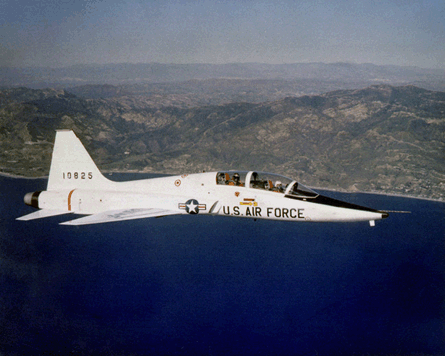The US Air Force has launched a market survey to acquire a new lead-in trainer in 2017, while crafting a careful strategy to preserve its ageing Northrop T-38C fleet through its planned retirement in 2026.
The survey seeks sources for a family of flying and simulated training systems tailored for the unique challenges of single-seat, fifth-generation fighters with 9g load systems, the USAF says.
The air force's 558-aircraft T-38C fleet is expected to remain in service for 17 more years, but has already entered its third lifecycle. The high-time aircraft has accumulated 16,000 flight hours, but was originally designed to retire after 7,000, says Lt Col Lloyd Addison, commander of the 506th sustainment squadron that maintains all T-38s.
The half-century-old fleet is showing its age. Two pilots were killed on 23 April 2008 in a T-38C crash in Colombus, Mississippi. An investigation revealed that a tiny part called an aileron actuation lever failed during pre-flight functional checks. A fleetwide inspection revealed that one-fourth of the T-38s were susceptible to the same part failure, Addison says.
 |
|---|
© Northrop Grumman |
The response to the inspections has been comprehensive. The USAF depot manufactured 3,000 new aileron actuation levers to replace the existing inventory. Addison's engineering cell surveyed the rest of the flight-control system, which prompted a need to check the fleet for bent control rods.
Meanwhile, six T-38Cs have been instrumented to collect a huge volume of structural and performance data over 1,000 flight hours by the end of the year, Addison says.
Despite the concerns about the T-38C's safety, the crash last year did not accelerate the replacement plan, Addison says.
"One of the questions asked of me was: can you get keep this fleet flying until you get to 2020?" Addison says. "We have the utmost confidence that we can keep the aircraft safely flying. Now I'll tell you we can't go past that retirement phase, and we've made that known."
The T-38C's age is not the only concern driving the replacement programme. The current trainer is limited to about 5g loads during aerial combat, which is insufficient for preparing pilots for the 9g capability of the Lockheed Martin F-22 and F-35 Lightning II.
"Students usually don't move the aircraft more than 3g, maybe 4," Addison says. "That's one of the reasons they need to go to a new jet trainer aircraft."
Source: Flight International























